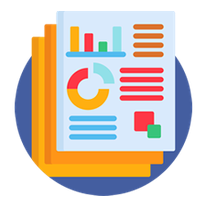Key Features:
No. of pages: 88
Introduction:
CHAPTER ONE
INTRODUCTION
1.1 BACKGROUND OF STUDY
Virtually all software used in enterprises today has the same goal which is supporting business processes. Some processes are entirely automated, relying solely on communication among applications, others probably rely on people to initiate the process, approve documents the process uses and resolve any exceptional situations that arise like incomplete information. In either case, it’s often possible to specify a discrete series of steps known as a workflow that describes the activities of the people and software involved in the process. Once this workflow has been defined, an application can be built around that definition to support the business process.
An office management is a set of activities organized hierarchically in a tree structure. Office management consists of a sequence of connected steps. It is a depiction of a sequence of operations, declared as the work of a person, a group of persons, an organization of staff, or one or more simple or complex mechanisms. Office management may be seen as any abstraction of real work, segregated in work share, work split or other types of ordering. For control purposes, it may be a view on real work under a chosen aspect, thus serving as a virtual representation of actual work. The flow being described often refers to a document that is being transferred from one step to another.
An office management system is a model to represent real work for further assessment, e.g. for describing a reliably repeatable sequence of operations. More abstractly, office management is a pattern of activity enabled by a systematic organization of resources, defined roles, and mass, energy, and information flow, into a work process that can be documented and learned. Offices are designed to achieve processing intents of some sort, such as physical transformation, service provision or information processing.
Office management concepts are closely related to other concepts used to describe organizational structure, such as silos, functions, teams, projects, policies and hierarchies. Office management may be viewed as one primitive building block of organizations.
The term office management is used in computer programming to capture and develop human-to-machine interaction. Office management software aims to provide end users with an easier way to orchestrate or describe complex processing
of data in a visual form, much like but without the need to understand computers or programming.
An activity represents an action in an office. It can be a complete activity that consists of several child activities. An activity can be sequential which means that the order of its action is specified at design time or the activity can be event-driven which means that the order of its action is determined at run time in response to external events.
Windows office management foundation is a Microsoft technology for defining, executing, and managing offices. Windows Office management foundation includes a default set of activities that provide functionality for control flow, conditions, event handling, state management, and communicating with applications and services. Windows office management foundation also provides an extensible model and designer to build custom activities that encapsulate office functionality for end users or for reuse across multiple properties.
Windows office management foundation comes with a programming model, a hostable and customizable office management engine, and tools for quickly building office management applications on Windows. It can be used to enable workflow within line of business applications, user interface page flows, document-centric workflows, human workflows, composite workflow for service-oriented applications, business rule-driven workflows and workflow for system management. It has the ability to monitor running office activities, examining it’s execution in real-time. Every office management system contains some number of activities, each of which performs some aspect of that workflow function. Office management acts as a container for these activities, providing a way to control their lifecycles and order of execution. Windows office management foundation aspires to support both system workflow and human office management in a unified fashion. System office management tends to execute activities in well-defined, predictable ways, while human office management does not. To address both of these requirements, windows office management foundation provides two built-in office management types: sequential office management capable of executing activities in a predefined pattern, and state machine office management capable of responding to external events as they occur.
Using an office management system to automate students’ registration process is very necessary because of the flexibility and convenience it will offer both to the institution and students. This research work when implemented will make it possible for students to do their registration electronically on the institution’s website. The workflow management system will then keep track of the student’s registration process from one department of the institution to the other until the registration process is completed. It will also give the student feedback anytime the student logs on to the school’s website to know his or her registration status. The workflow will also create an automatic database for the storage of the student’s electronic form.
Buy Now
